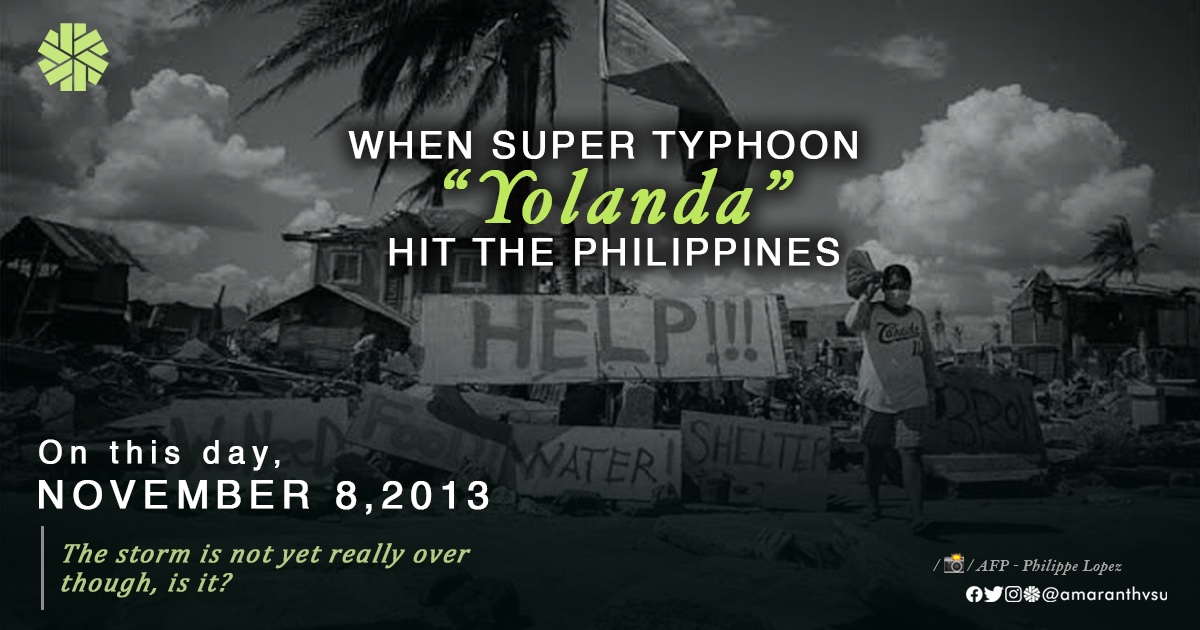Picture this: the wind swept in with an angry surge that shattered everything in its path, images of wreckage strewn around like in a post-apocalyptic movie, vulnerable people jammed into shelters in dreadful situations, and the seeming hopelessness and desperation that were becoming more and more apparent each waking moment.
So much can be said about Super Typhoon Yolanda, one of the deadliest tropical cyclones ever recorded. It was the 8th of November 2013—the day when it buffeted the island of Visayas, particularly Samar and Leyte, which affected nearly 14 million people and damaged 1.1 million homes.
Everything was destroyed by the storm, both architecturally and emotionally. Lives were lost, infrastructures were destroyed, and souls were broken. The affected residents were already exhausted from having to flee and rebuild the damages done to their homes and families.
𝐅𝐢𝐫𝐬𝐭 𝐞𝐜𝐡𝐨: 𝐓𝐡𝐞 𝐧𝐢𝐧𝐞 𝐲𝐞𝐚𝐫𝐬 𝐨𝐟 𝐭𝐫𝐚𝐮𝐦𝐚
It has been nine years since the cataclysmic event, but the typhoon's lasting effects can still be felt, lingering like ghosts in the wind. Every year, we commemorate the tragedy to remember those who suffered, to remember the long-term recovery we went through, and to acknowledge the global aid, and the lessons we learned from it. But the storm is not yet really over though, is it?
Inevitably, there will be ten or more storms each year, and we have no way of avoiding them due to our country's geographical location. And each one feels like one trauma after another -- serving as a reminder of the destruction brought on by Super Typhoon Yolanda.
As storms and cyclones become more intense and frequent as a result of climate change, there is an urgent need for action, especially since we live in a developing country some areas are more vulnerable to extreme disasters. Many natural areas were damaged, including coconut plantations and fisheries, which are vital sources of employment for most Filipinos.
𝐒𝐞𝐜𝐨𝐧𝐝 𝐞𝐜𝐡𝐨: 𝐅𝐢𝐥𝐢𝐩𝐢𝐧𝐨 𝐫𝐞𝐬𝐢𝐥𝐢𝐞𝐧𝐜𝐞 𝐚𝐧𝐝 𝐠𝐨𝐯𝐞𝐫𝐧𝐦𝐞𝐧𝐭 𝐜𝐨𝐫𝐫𝐮𝐩𝐭𝐢𝐨𝐧 𝐢𝐬 𝐬𝐨𝐦𝐞𝐭𝐡𝐢𝐧𝐠 𝐭𝐡𝐚𝐭 𝐝𝐨𝐞𝐬 𝐧𝐨𝐭 𝐜𝐨𝐧𝐧𝐞𝐜𝐭 𝐰𝐞𝐥𝐥
While it is important to acknowledge the survivors' resilience that shone brightly in the aftermath of the typhoon, it is also important to remember that the reason for this fortitude was that they had received inadequate assistance in the first place. Since the government's initial response to the terrible tragedy of Typhoon Yolanda was marked by extreme incompetence, the survivors just had to rely on romanticizing resilience just to make sense of the injustices they didn't even know existed.
Some other things are perpetually typhoon-proof– Filipino resilience and government corruption. The global community did whatever it could to help us rebuild, but it was reported that hundreds of millions of pesos in funds meant for relief distribution and rehabilitation were allegedly pocketed by government offices instead of giving it to the victims. The Commission on Audit (COA) released its report on Typhoon Yolanda Relief Operations back in 2014 and acknowledged the injustices that happened behind the tragedy.
𝐓𝐲𝐩𝐡𝐨𝐨𝐧 𝐘𝐨𝐥𝐚𝐧𝐝𝐚 𝐦𝐢𝐠𝐡𝐭 𝐡𝐚𝐯𝐞 𝐛𝐞𝐞𝐧 𝐨𝐯𝐞𝐫 𝐧𝐢𝐧𝐞 𝐲𝐞𝐚𝐫𝐬 𝐚𝐠𝐨, 𝐛𝐮𝐭 𝐬𝐚𝐝𝐥𝐲, 𝐢𝐭 𝐥𝐨𝐨𝐤𝐬 𝐥𝐢𝐤𝐞 𝐰𝐞 𝐥𝐞𝐚𝐫𝐧𝐞𝐝 𝐥𝐢𝐭𝐭𝐥𝐞 𝐟𝐫𝐨𝐦 𝐢𝐭. 𝐇𝐨𝐰 𝐦𝐚𝐧𝐲 𝐞𝐬𝐬𝐚𝐲𝐬 𝐬𝐡𝐨𝐮𝐥𝐝 𝐰𝐞 𝐰𝐫𝐢𝐭𝐞, 𝐩𝐫𝐚𝐲𝐞𝐫𝐬 𝐬𝐡𝐨𝐮𝐥𝐝 𝐰𝐞 𝐩𝐫𝐚𝐲, 𝐨𝐫 𝐜𝐚𝐧𝐝𝐥𝐞𝐬 𝐬𝐡𝐨𝐮𝐥𝐝 𝐰𝐞 𝐥𝐢𝐠𝐡𝐭 𝐞𝐯𝐞𝐫𝐲 𝐲𝐞𝐚𝐫 𝐟𝐨𝐫 𝐮𝐬 𝐭𝐨 𝐫𝐞𝐚𝐥𝐢𝐳𝐞 𝐭𝐡𝐚𝐭 𝐭𝐡𝐞 𝐬𝐭𝐨𝐫𝐦 𝐢𝐬 𝐧𝐨𝐭 𝐲𝐞𝐭 𝐨𝐯𝐞𝐫?


